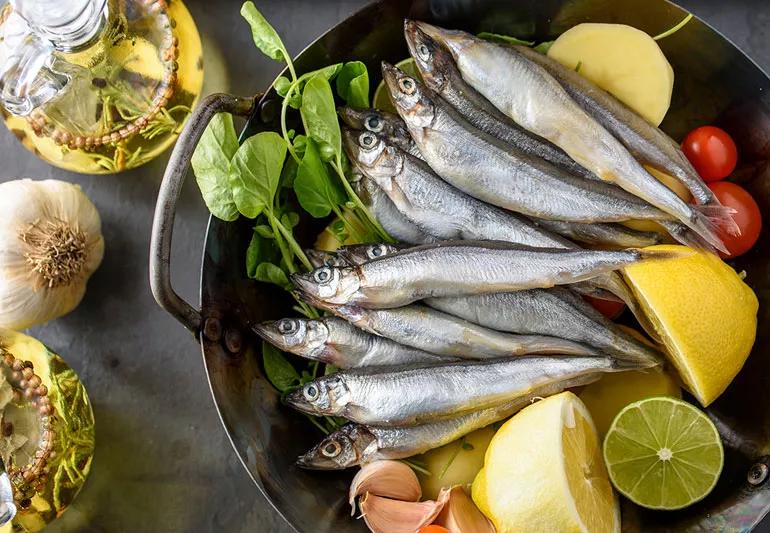Expand your protein options with these varieties

From sardines to mackerel, fish has a multitude of benefits ranging from omega-3 acids to protein. However, there are a few varieties that are healthier for you than others. Registered dietitian Julia Zumpano, RD, LD, breaks down the three fish that deserve more attention and three that you should avoid.
Advertisement
Cleveland Clinic is a non-profit academic medical center. Advertising on our site helps support our mission. We do not endorse non-Cleveland Clinic products or services. Policy
Sardines provide a variety of benefits.
“You can’t go wrong with sardines,” says Zumpano. “They’re a wonderful source of omega-3 fatty acids, they’re caught in the wild and they’re cheap.”
Sardines provide 2 grams of heart-healthy omega-3s per 3 ounce serving, which is one of the highest levels of omega-3 and the lowest levels of mercury of any fish. They contain a great source of calcium and Vitamin D, so they support bone health, too. Other than fortified products, there are few other food sources of Vitamin D. They may be packed in water, tomato juice or olive oil. Read the label to make sure you don’t exceed your daily limits for sodium and fat.
“Since sardines are more likely to be sustainably caught, they’re a safe choice for pregnant and nursing women,” notes Zumpano.
Worried about encountering the entire fish, head intact? Today, only the edible portions are included. Try serving sardines sprinkled with lemon juice and 1 teaspoon of olive oil or with chopped tomatoes and basil, oregano or another Italian seasoning. For a quick snack, serve sardines on whole grain crackers.
Fatty fish like herring provide around 1.5 grams of omega-3s per 3 ounce serving. Herring also boasts more omega-3 fatty acids than either salmon or tuna, which are essential to human health since our bodies can’t make these fats.
Advertisement
Herring contains less mercury than other omega-3-rich fish you may be eating, like tuna, king mackerel, swordfish and halibut.
“Try it chilled, with a light marinade of white wine vinegar, red onion and dill,” says Zumpano. “Another popular option is to pair herring with mustard and dill.”
Atlantic and Atka mackerel from Alaska are high in inflammation-fighting omega-3s and low in mercury, but not all mackerel get a thumbs-up. King mackerel, from the Western Atlantic and Gulf of Mexico, has a high mercury content. Zumpano suggests limiting Spanish mackerel as well due to mercury concerns.
“Try grilling or poaching mackerel to throw over a salad, or serve it with a side of grilled veggies,” she notes.
Meanwhile, think twice about ordering these popular fish or adding them to your grocery cart:
“Sure, tilapia is a lean source of protein, but it lacks the omega-3 content of fatty fish like salmon, tuna, herring and sardines,” says Zumpano.
Most people don’t get enough omega-3s in their diet. If you’re going to enjoy fish, it’s best to choose fish that are highest in this essential nutrient.
“Fresh tuna is a great source of omega-3s,” says Zumpano. “But everyone’s desire for sushi may be putting us at risk for mercury toxicity.”
Exposure to high levels of mercury increases the risk of cognitive defects and other health problems. You’re not necessarily safer with canned tuna, either. Albacore tuna, one of the more popular fish in the United States, is consistently high in methylmercury.
“The same is true for canned light tuna unless you’re purchasing from a company that checks the mercury levels of each can,” continues Zumpano. “But very few companies currently take this extra step.”
Catfish, which is 90% imported, often comes from contaminated waters and may contain dangerous chemicals and antibiotics. If you love your catfish, choose farm-raised varieties from American waters or try Asian carp, which has a similar taste.
The next time you’re weighing dinner options, follow these tips for choosing fish that are high in omega-3, low in mercury, safely sourced and sustainably caught. When purchasing canned fish, be sure that it’s BPA-free. You’ll find yourself enjoying some menu options you haven’t tried before.
Advertisement
Learn more about our editorial process.
Advertisement

With a focus on internal cues for hunger and fullness, this eating style may revolutionize your relationship with food

Review the ingredients, watch for sugar and fat, and choose one with the right amount of protein for your needs

A typical recommended balanced diet is half fruits and veggies, a quarter protein and a quarter grains

Foods high in protein, fiber and water can help keep hunger at bay

This quirky food trend is harmless, as long as you’re getting enough protein, fiber and healthy fats

This vital nutrient helps your brain and body in many ways — and most of us need more of it

Wrapped or sandwiched, try to choose fillings and condiments that are minimally processed, low in saturated fat and high in fiber

Set yourself up for success by carefully choosing your recipes, storage containers and prepping day

Babies can get congested easily, but you can calm their cough by keeping them hydrated, using nasal drops and running a humidifier

Weight loss may cause loose, sagging skin and muscle loss to your rear

Several conditions, like vitiligo and fungal infection, can cause a loss of pigmentation, leading to white spots or patches on your skin